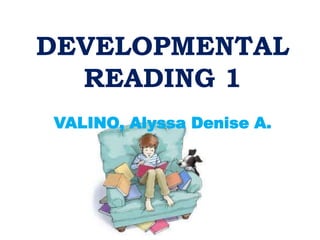
Developmental reading 1
- 1. DEVELOPMENTAL READING 1 VALINO, Alyssa Denise A.
- 3. OBJECTIVES • Evaluate the interactive reading model • Integrate analysis of the language in reading • Gain deeper understanding and appreciation for the value of literature
- 5. INTRODUCTION • “The most beautiful things in the world cannot be seen or touched, they are felt with the heart.” ― Antoine de Saint-Exupéry, The Little Prince • “A rock pile ceases to be a rock pile the moment a single man contemplates it, bearing within him the image of a cathedral.” ― Antoine de Saint-Exupéry, The Little Prince
- 6. INTERACTIVE READING MODEL • An attempt to combine the two models, the top-down and the bottom-up. • It selects the strong points of both models and integrates them in learning to read.
- 7. Researchers’ view about the model • Emerald Dechant Meaning is constructed by the selective use of information from various sources, without relying on any set order. these sources may be graphemic, phonemic, morphemic, syntax and semantics. All levels of processing are used although the reader can rely on one source at a given time.
- 8. • Kenneth Goodman Reading is understood at once as both a perceptual and cognitive process. Researchers’ view about the model
- 9. • To be able to accomplish the task of reading, a skilled reader must be able to use sensory, syntactic, semantic, and pragmatic situation. • During the process of reading, various sources of information may interact in many complex ways. Researchers’ view about the model
- 10. ICEBREAKER
- 11. REFLECTION When giving interpretation to what one has read, one should not only focus on the text nor the reader. Giving meaning to the text could also be done by combining the essential feature of he bottom-up and the top-down model. We should always remember that there are some text that was not meant to be taken literally as its words suggest. We should also not derive solely the meaning of what we read based only from our own prior knowledge of the topic. We should learn to incorporate a little bit of those two (reader, text).
- 13. INTRODUCTION • Literature tells you many things. It tells you the stories of real people who grapple with problems that the urgency in today’s living brings. It recounts the experiences of ordinary country folk who delight at the simple joys of life. it narrates the exploits or adventures of the immortals and the supernatural beings who thrill us with their incredible powers.
- 14. • Literature relates all these things through its elements such as poetic language, tone and mood, character, setting, plot and theme. LITERARY APPRECIATION SKILLS
- 15. 1. POETIC LANGUAGE Words or phrases that conjure up vivid pictures in your mind, that appeal to your emotions, or that communicate ideas beyond the literal meanings of the words Images appeal to the senses of sight, touch, and hearing although the majority of images are visual. LITERARY APPRECIATION SKILLS
- 16. 2. TONE AND MOOD The attitude that a writer takes toward a subject is tone. It may be angry, bitter, humorous, nostalgic or serious. LITERARY APPRECIATION SKILLS
- 17. 2. TONE AND MOOD The feeling or atmosphere that the writer creates for the reader is mood. It may be joyful, quiet, optimistic, or sad. Figurative language, images, details and setting convey mood. LITERARY APPRECIATION SKILLS
- 18. 3. CHARACTER The people or animals who take part in the action of fiction and even poetry are characters. LITERARY APPRECIATION SKILLS
- 19. 3. CHARACTER The writer’s use of characterization techniques helps in giving you an impression of the characters. These techniques may be physical description, the words and actions of the characters, the reactions of the other characters to the individual, and the character’s expression of her own thoughts and feelings. LITERARY APPRECIATION SKILLS
- 20. 4. SETTING The time and place of the action comprise the setting of a literary work. In most stories, it serves as a backdrop in which the characters interact. In others, it is used to reveal character, help develop plot, and create mood. LITERARY APPRECIATION SKILLS
- 21. 5. PLOT the arrangement of events in a short story Its most important elements include the conflict, the climax, and the resolution. Conflict is the point at which the conflict is greatest. The resolution is the outcome of the conflict. LITERARY APPRECIATION SKILLS
- 22. 6. THEME the main idea of a literary work To determine the theme, you need to consider all the elements of literature although most writers reveal the theme through characters. LITERARY APPRECIATION SKILLS
- 23. ACTIVITY How can you say the following using poetic language? o You are beautiful. o You smell nice/fragrant. o It is too noisy. o I love you.
- 24. REFLECTION Literature has already been a part of our lives, not only in the academic but also in the personal sense. We gain a lot of things from literature: knowledge about other people’s cultures, novel ideas, thoughts about the mysteries of life, and some form of escape from the struggles that we encounter in our modern world. With these in mind, we should learn to appreciate literature and its wonders. We should understand its value and give importance to the part that it has played all through the years. And most of all, we should learn to esteem, honor, respect and admire the beauty and complexity of literature.
- 25. LEARNING TASK 9 A. Which model/theory is easier to apply: bottom- up, top-bottom, or interactive theory? Explain. B. Search for Edgar Allan Poe’s poem, Annabel Lee and identify the following elements: • Poetic Language (give at least 3 examples) • Tone and mood • Characters • Setting • Summary or plot • Theme • Reflection
- 26. Thank you for listening!
